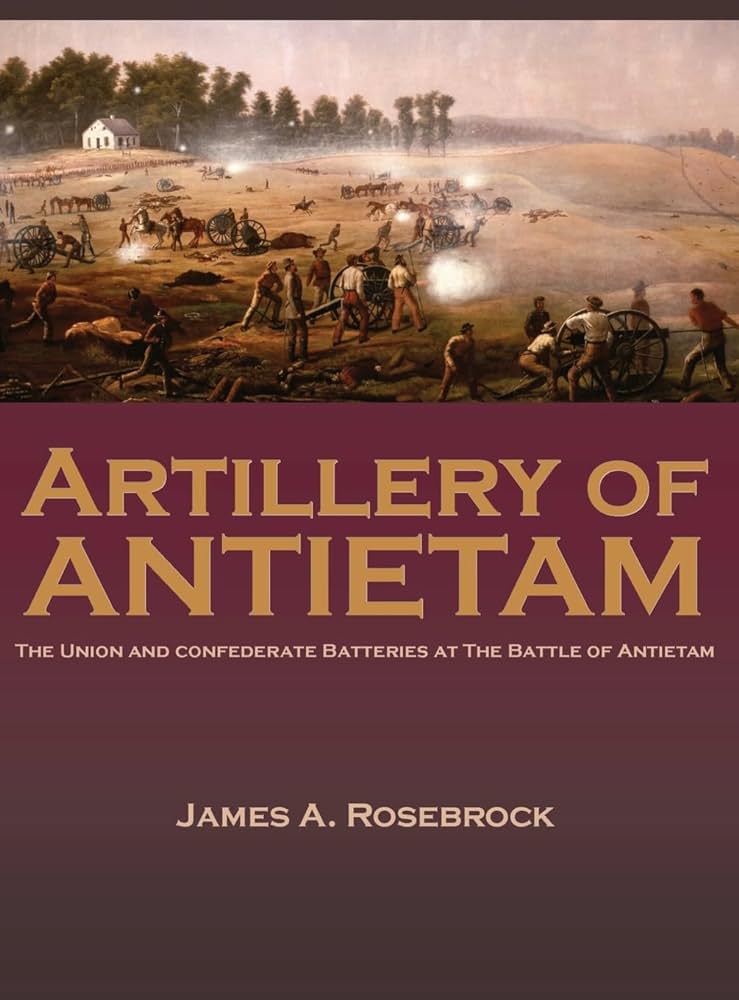Book Review: Artillery of Antietam: The Union and Confederate Batteries at the Battle of Antietam

 Artillery of Antietam: The Union and Confederate Batteries at the Battle of Antietam. By James A. Rosebrock. Sharpsburg, MD: The Antietam Institute, 2023. Hardcover, 446 pp. $44.95.
Artillery of Antietam: The Union and Confederate Batteries at the Battle of Antietam. By James A. Rosebrock. Sharpsburg, MD: The Antietam Institute, 2023. Hardcover, 446 pp. $44.95.
Reviewed by Tyler McGraw
In 2021, the Antietam Institute published The Brigades of Antietam: The Union and Confederate Brigades during the 1862 Maryland Campaign, edited by Bradley M. Gottfried, which provides accounts of the battle’s major infantry and cavalry units. Gottfried’s book is an essential reference study for any Antietam student. Two years later, the Institute published a follow-up companion volume titled Artillery of Antietam: The Union and Confederate Batteries at the Battle of Antietam by James A. Rosebrock. Often referred to as “Artillery Hell,” Antietam’s landscape in most cases was ideally suited for the implementation of both armies’ “long arm,” and thus it played crucial roles during the day’s combat. Although it has been almost 30 years since a study appeared on this particular subject, Rosebrock’s comprehensive book capably fills that lengthy void of scholarship and exceeds the scope and content of previous works.
Highlighting the book’s opening is a section containing 28 highly detailed topographic campaign maps. These thoroughly researched maps help readers better understand the many movements made by the artillery during the 1862 Maryland Campaign. The maps’ topographic lines reflect the landscape in 1862 and remove post-battle modern features, including the walls of the Antietam National Cemetery. Understanding topography was vital for artillerists. Having these maps at hand, with their high level of detail, adds significantly to the book’s value and helps readers better visualize the battles of the campaign.
Another excellent feature of this study is a seven page section titled “Artillery Organization in the Maryland Campaign.” Here Rosebrock provides a brief background that serves as an excellent introduction for new learners—or as a refresher for those that may already be more familiar with Civil War artillery. In this chapter he shares an array of information about command structure, the roles of the men who worked the pieces, drivers and horses, support personnel, guns, and ammunition.
Rosebrock then proceeds to breakdown the Army of the Potomac’s and Army of Northern Virginia’s artillery to the divisional level, and he offers information about the various units, what type of guns they fought with, and he even details the strengths and losses during the campaign. Rosebrock is meticulous with his research and provides extensive citations at the end of each chapter section.
For those that may not be familiar with Civil War artillery and the differences between Union and Confederate units, Artillery of Antietam does a phenomenal job of explaining what those differences were. While divisional chiefs of artillery, which were usually captains, led the Army of the Potomac’s artillery just above the battery level, the Army of Northern Virginia utilized artillery battalions that were led normally by majors and lieutenant colonels.
When it comes to the individual Union artillery divisions and Confederate battalions, Rosebrock’s breakdown is easy to follow and starts with the identification of the units that made up these organizations. Following the list of batteries, there is detailed background information that serves as an introduction to the units and then a description of the artillery division/battalion’s experience during the Maryland Campaign. These obviously vary in length due to the amount of action each one experienced at engagements like Harpers Ferry, South Mountain, and of course, Antietam. Each of the organizations close with a conclusion.
The Army of the Potomac and Army of Northern Virginia artillery division/battalion sections make up the majority of the book. However, there are also seven appendices at the end that offer readers a wealth of resource information including an artillery order of battle, strength numbers and casualty figures for the both the Army of the Potomac and Army of Northern Virginia, and an armament list showing the types of guns for both belligerents. The final two appendices provide a list of the armies’ artillery generals and field grade officers during the Maryland Campaign, as well as Col. (soon-to-be Brig. Gen.) Henry Hunt’s September 12, 1862, order explaining his instructions for the employment of artillery.
James Rosebrock’s Artillery at Antietam serves as an excellent reference book and a most welcome addition to Maryland Campaign and Antietam scholarship. General Civil War enthusiasts, as well and the most hardcore of 1862 Maryland Campaign students, will find it accessible and extremely helpful in understanding the important role this branch of service played in a pivotal campaign of the conflict.
Tyler McGraw is the founder of The Unfiltered Historian Podcast and is site manager for the Manassas National Battlefield Bookstore. Tyler is an avid reader of anything Civil War and enjoys spending time on battlefields in the central Virginia area, as well as at Antietam and Gettysburg.
I enjoyed your review because it objectively detailed exactly what will be found in the book in plain language.
Good review. I actually forgot there was artillery at Antietam, save the “cornstalk” story.
Gottfried’s work was so goods. If Rosebrock’s is half as good, it will be awesome. Several years ago I attended a Chambersburg Seminar that covered the artillery @ Antietam(and Gettysburg). The Antietam terrain does support the use of artillery(as opposed, for example, Chicamauga).